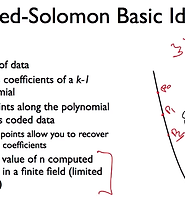| 일 | 월 | 화 | 수 | 목 | 금 | 토 |
|---|---|---|---|---|---|---|
| 1 | 2 | 3 | 4 | |||
| 5 | 6 | 7 | 8 | 9 | 10 | 11 |
| 12 | 13 | 14 | 15 | 16 | 17 | 18 |
| 19 | 20 | 21 | 22 | 23 | 24 | 25 |
| 26 | 27 | 28 | 29 | 30 | 31 |
- MYSQL
- 맥
- node.js 연동
- 파이썬3
- Windows10
- mongoDB [Object]
- mongo-native
- console.log
- pip jupyter
- nodejs mongodb
- homebrew
- mongodb
- 맥에 파이썬 설치
- util.inspect
- mongodb nodejs driver
- Jupyter notebook
- Node.js
- node.js설치
- Installation
- python3
- Projection
- [Object]
- MacOS
- query
- collection.find
- Today
- Total
Bon Voyage
CS144 7-3 Clocks and Clock Recovery 본문
Introduction to Computer Networking, Stanford University
https://lagunita.stanford.edu/courses/Engineering/Networking-SP/SelfPaced/about
Unit 7: Lower Layers 중 Clocks and Clock Recovery 파트 수업 필기 정리
Clocks
-
data is transmitted using a 'clock'
-
the receiver needs to know when to sample the arriving data

when the clocks are running at different speed- how different are these clocks?
- units of parts per million
- ± 100 ppm = ±0.01%but usually the clocks are not drifting quickly, so offsets are relatively fixed
- how different are these clocks?
Asynchronous Communication

- make sure the packet not too long (control p)
- if we know the tolerants between the clocks to reliably decode the packet
Synchronous Communication
used in more practical situations
- Encoding the clock with the data
- Recovering the clock
- Getting the data into the receiver's clock "domain"

- Sender sends 10mega bits per second (using 10MHz clock) through network link
- in Transmit Clock Domain, Clock Recovery Unit recovers the 'sender's clock'
- put the data into Elasticity Buffer
- Receiver(RX) processes it with its own clock
How to send clock info encoded?

-
make sure there's sufficient transitions in it,
otherwise the clock recovery unit could think it as half or doubled signal
Manchester (En)Coding

- 0 at downwards transition
- 1 at upwards transition
- d.c. balance? → set a threshold voltage level between 0 and 1 transition, so the recovery unit distinguishes transitions better
- But in this way, we need to insert more transitions than we need (doubling the bandwidths in the worst case)
4B5B Encoding

4-bit data = 4 bits of original data
5-bit data = 5 bits of encoded data
- this encoding method guarantees that there are some certain transitions
- you can always be sure that outgoing data has enough transition in it
- Fewer transition than Manchester coding, but people have developed the circuits so now it's most commonly used
Problem Set
Question 1
An infrared remote control uses asynchronous communications to send 64 bits of data using a 1MHz clock. The clocks at the two ends differ by at most 10kHz.
(10kHz is 1% of 1MHz. 1% = 10,000 ppm)
True Statement
If the receiver’s clock is 10kHz faster than the transmitter’s clock, then we will count a bit twice.
Question 2
True statements about Manchester coding?
Answers
- Used to introduce transitions between 0 and 1 to aid clock recovery
- Guarantees a transition during every bit time
Question 3
You friend discovers another form of block coding: 4B/6B, and she asks you to compare it Manchester coding and 4B/5B. Which of the following might you discover in your analysis?
Answers
- The overhead of 4B/6B will be less than Manchester coding but more than 4B/5B.
- 4B/6B will allow for more control codes than 4B/5B and Manchester coding.
'개념 공부 > 네트워크' 카테고리의 다른 글
| CS144 7-5 CSMA/CD and Ethernet (0) | 2019.10.01 |
|---|---|
| CS144 7-4 FEC and Reed-Solomon (0) | 2019.09.27 |
| CS144 7-2 Bit Errors (0) | 2019.09.27 |
| CS144 7-1 Shannon Capacity and Modulation (0) | 2019.09.25 |




